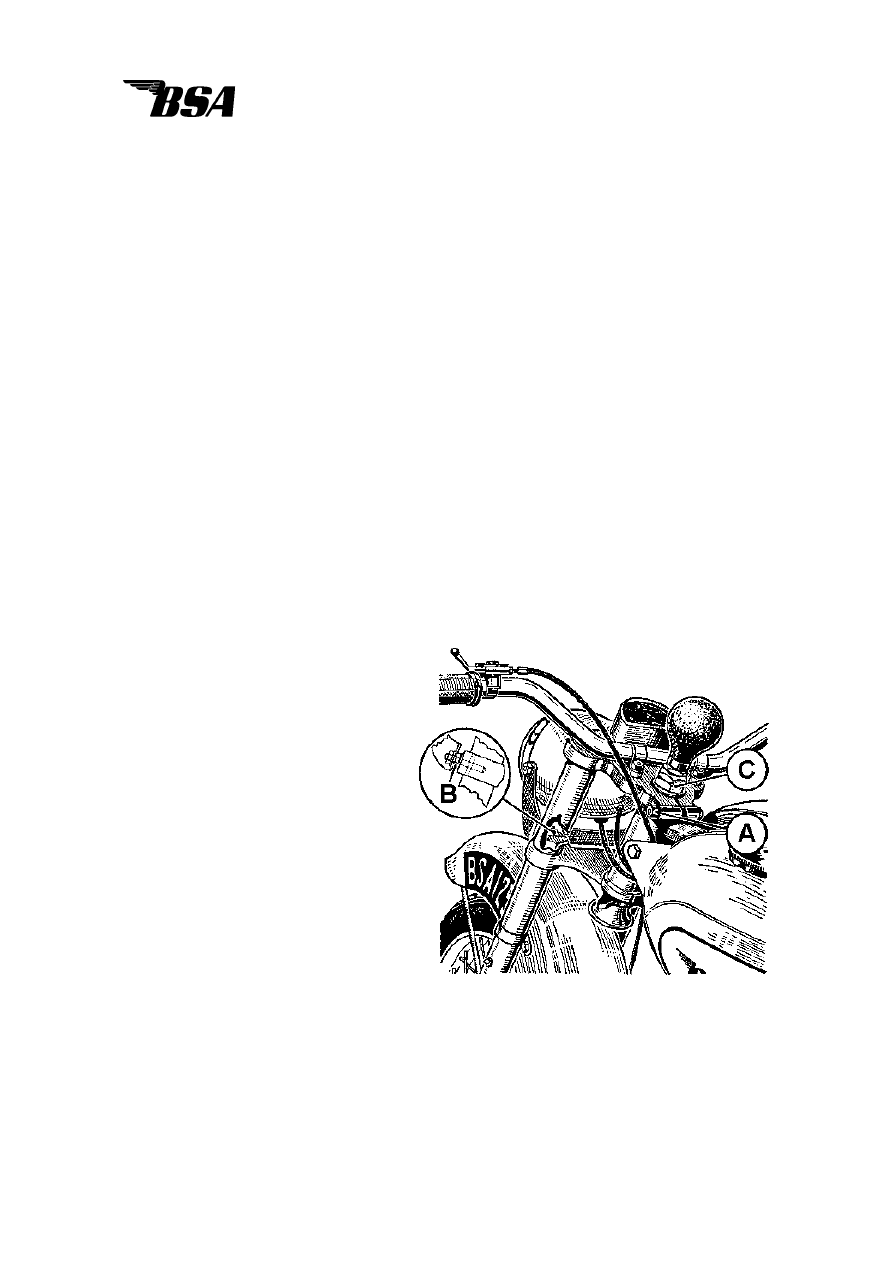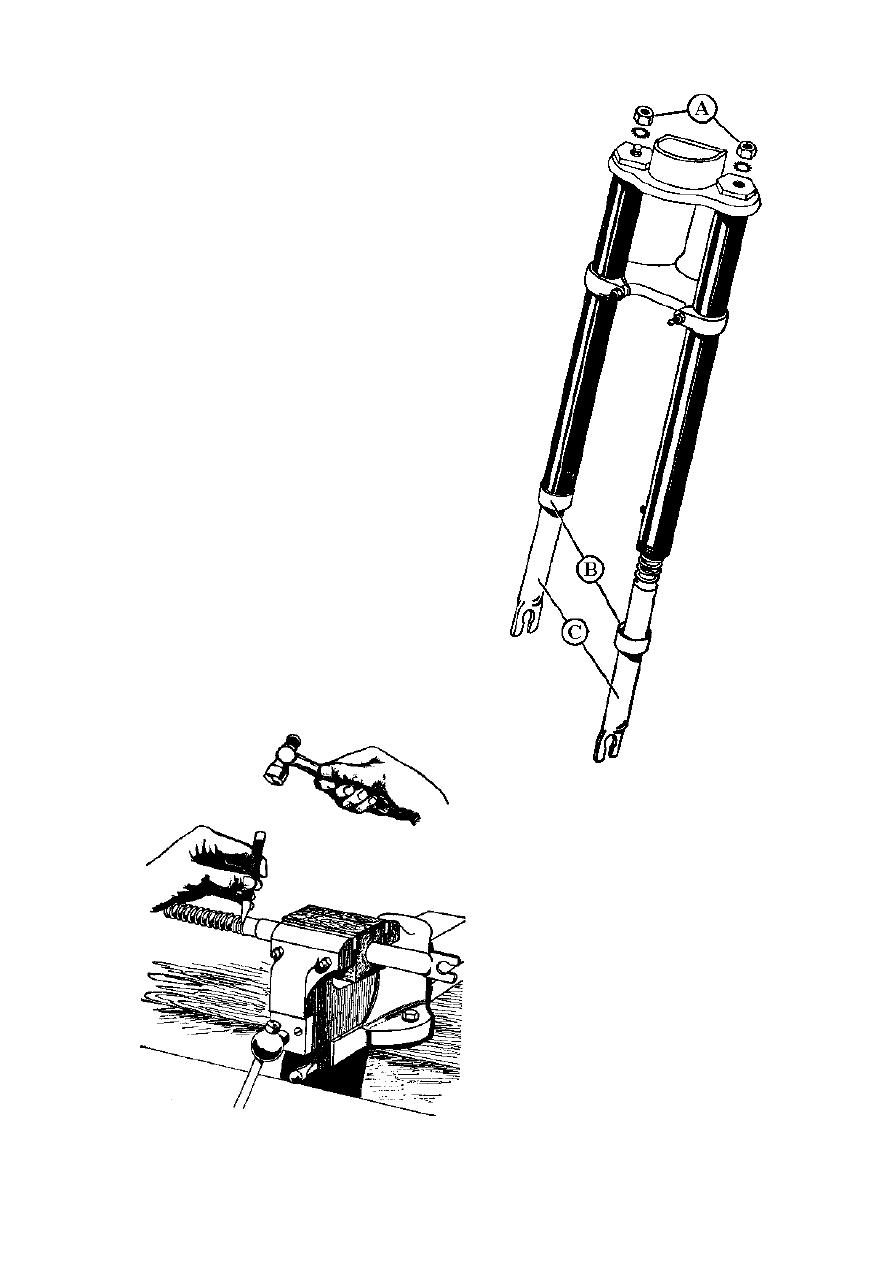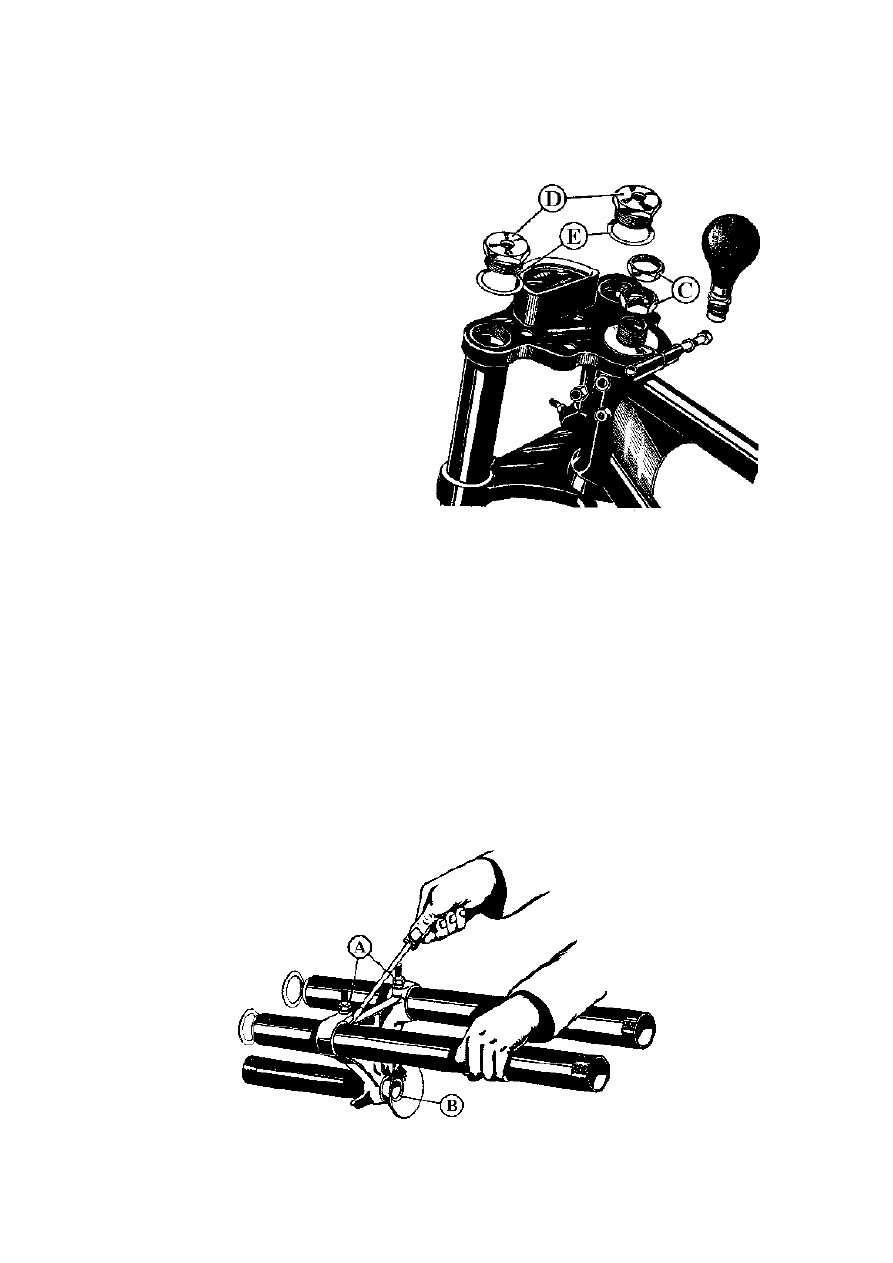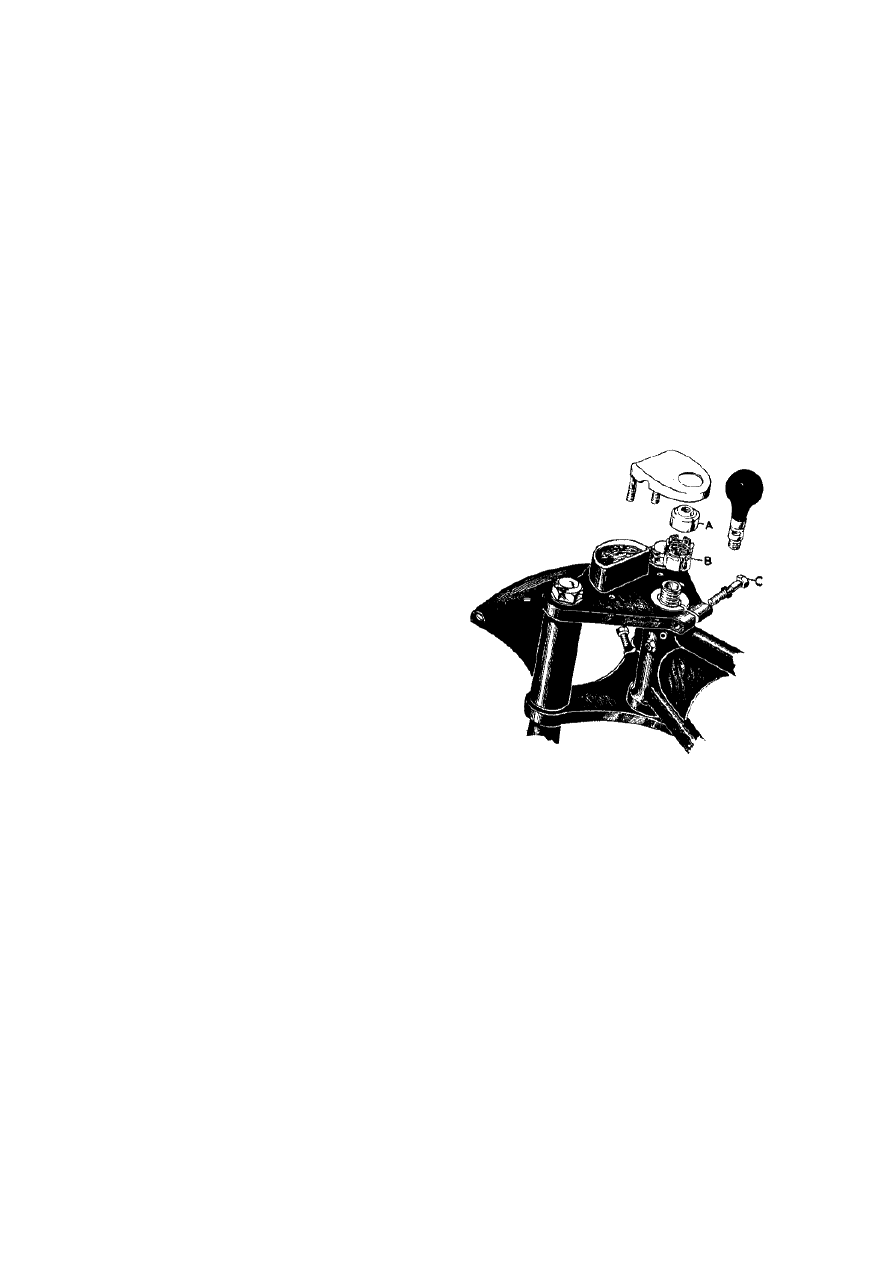
F
IG
. D24. Front fork and steering head.
SERVICE SHEET No. 509
Reprinted November 1965
Models D1, D3, D5 and C10L ― up to 1956
(for C10L 1956 onwards, please see Service Sheet No. 706)
REMOVAL AND DISMANTLING OF THE FRONT FORKS AND
STEERING HEAD
Remove the front wheel as described in Service Sheet No. 508.
If only attention to the sliding members and bushes is required it is not necessary to
dismantle the top part of the fork assembly but the mudguard must be unbolted from the
lower fork members. On early D1 models the mudguard is attached to the upper fork
tubes and removal is only necessary if the forks are to be completely dismantled.
Free the top end of the telescopic gaiters from the oil sea1 holders (
B
) Fig. D25, and
slide the gaiters down the lower tubes. Remove the locking clips engaging in the top
groove of the oil seal holders, which can then be unscrewed. On early models these clips
are secured by the mudguard stay studs and later by the grease nipples which are screwed
into the outer fork tube. Very early D1 models have no locking clips and the fork bushes
on these models are non-detachable.
Remove the two small nuts (
A
)
Fig. D25, from the top of the two
large nuts in the top yoke. On D3
and C10L models the small domed
caps must first be removed. They
should be levered up with the tang of
a file inserted in the small hole in the
edge of the dome. The sliding
members complete with their springs
can then be withdrawn from the
bottom of the fixed tubes.
To detach the springs, hold the
lower leg in a vice, as shown in Fig.
D26, and using a small punch tap the
spring from its thread. The spring
can be removed from its upper end
housing in a similar manner. Some
models have a rubber tube fitted inside the spring to increase the resistance of the fork,
and this can only be removed if one end of the spring is detached.

B.S.A. Service Sheet No. 509 (contd.)
With the sliding tubes removed the lower fork
bushes can be withdrawn. Removal of the grease
nipples in the side of the outer legs will allow the
fork bush distance piece and top bush to be pulled
out of the fork outer tube with the aid of a spoke
or other similar tool. On D1 models before frame
No. YD1-57331 the fork bushes are
non-detachable and if they show signs of wear
then the fork outer tubes complete must be
replaced by the later type.
Detach the clutch cable from the handlebar
lever and remove the headlamp switch handlebar
lever, when fitted. Removal of the four nuts
beneath the fork top yoke which retain the
handlebar clips or aluminium cover plate will
allow the handlebars to be lifted away from the top
yoke. If a bulb type horn is fitted in the steering
head this should be removed before the
handlebars.
From this point onwards the dismantling
procedure for the D1 fork is slightly different from
that for the other models and will be described
first.
Remove the two nuts (
D
) Fig. D27, together
with washers (
E
) and the two locknuts (
C
).
Remove the headlamp from its bracket and lower
it to the full extent of the wiring harness. This will
allow access to the underside of the top yoke so
that the speedometer cables can be disconnected
and the instrument removed.
F
IG
. D26. Removing the front fork springs.
Fig. D25.
Slackening off the pinch bolt at
the back of the top yoke will permit
the yoke to be removed and placed
aside, noting that it will be necessary
to hold the lower part of the fork in
position to prevent the balls of the
lower head bearing dropping away.
Pull the headlamp cowl assembly
(when fitted) off the fork outer tubes
and lift the headlamp over the forks so
that it is resting securely on the petrol
tank. As the remainder of the fork is
withdrawn from the frame head a
piece of clean rag should be held
underneath the bottom yoke to catch
any ball bearings which may escape.

B.S.A. Service Sheet No. 509 (contd.)
To remove the outer fork tubes place the assembly on a bench and slacken the pinch
nuts (
A
) Fig. D28, in the bottom yoke. Expand the slots in the yoke by inserting a
screwdriver as shown in Fig. D28 and
draw the tubes down until they are
resting on the large washers. Replace
the nuts (
D
) and tap gently to remove the
washers. The fork outer tubes can now
be withdrawn.
The trumpet part of the horn (when
fitted) can be removed by unscrewing
the slotted collar (
B
) Fig. D28.
On D3, D5 and C10L models the
outer tubes are a taper fit in the top yoke
and they should be freed by undoing the
pinch nuts (
A
) Fig. D28, in the lower
yoke and slackening the top nuts (
D
)
Fig. D27, by about two turns. A sharp
tap on the head of the nut with a hide
mallet will free the tube and dismantling
can then proceed as for the D1.
To remove the top yoke it is not necessary to undo the castellated sleeve nut on the
fork stem and this will hold the lower part of the fork in position until it is ready to be
removed.
When the forks have been dismantled the bearing cups can be removed from the
frame head by screwing in Service Tool 61-3060 and driving them out from the opposite
end with a suitable punch. Do not disturb the cups unless they are pitted or otherwise
damaged.
Reassembly
New cups in the steering head should be driven in carefully and squarely to avoid damage
and obtain correct alignment. This can best be done with a hide mallet. Grease the cups
and place twenty-four
3
/
16
in. balls in each cup.
Assembly can then be carried out in the reverse order to dismantling. Do not forget
the rubber washers at the bottom of the headlamp cowl tubes (when fitted), the washers
on top of the main fork tubes (D1 models), and the dust cover over the top bearing.
Fig. D28.
Fig. D27.

B.S.A. Service Sheet No. 509 (contd.)
On D1 models, when replacing the nuts (
C
) Fig. D27, ensure that the thicker of the
two nuts is at the bottom with its recess facing downwards.
D1 Steering Head Adjustment
Thc method of adjusting the steering head bearings on the D1 models is different to that
for the other models. Thc forks should be completely assembled but only the large nuts
(
D
) Fig. D27, should be tightened, after ensuring that the mudguard stay studs on the fork
outer tubes are facing each other and in line. Where the mudguard is attached to the
sliding tubes, the two grease nipples should be facing outwards. Tighten down the lower
of the two nuts (
C
) Fig. D24, until the forks rotate freely but have no up and down play.
Secure the lower nut by means of the locknut and then check to ensure that the bearing is
not over-tightened. A “lumpy” feeling as the forks are turned indicates that the
adjustment is too tight. When this adjustment is completed the top yoke clamp nut (
A
)
Fig. D24, and the lower clamp nuts (
B
) should be tightened securely.
D3 and C10L Steering Head Adjustment
The fork can be completely assembled and
all the nuts fully tightened before the
steering head adjustment is carried out.
The fork should bc assembled so that the
headlamp cowl tubes are held firmly
between the top and bottom fork yokes,
with the rubber washers at the lower end of
the tubes and the steel washers on top. The
fork nuts can then be fully tightened with
the exception of the stem nuts and the pinch
bolt at the rear of the top yoke. Thc
castellated sleeve nut (
B
) Fig. D29, should
then be screwed down with the aid of
Service Tool, part number 61-3002, or other
similar tool until the forks rotate freely but
without up and down play. Tighten the
pinch bolt nut (
C
) to secure the sleeve nut
and replace the top cap (
A
). Check that the
bearing adjustment is still correct and replace the handlebar assembly.
Sliding Tube Reassembly (all models)
Place the upper bushes in the outer tubes and push them up as far as they will go with the
aid of the distance tube. Line up the holes in the distance tubes with the grease nipple
holes in the outer tubes and screw in the nipples. Position the telescopic gaiters on the
lower tubes together with the oil seal holders and lower fork bushes. Take care that the
oil seals arc not damaged as they pass over the springs. Grease the springs and sliding
members, then pass them up into the outer tubes. Position the lower bushes and screw up
the oil seal holders. Secure the upper end of the springs in position by means of the nuts
(
A
) Fig. D25, making sure that the fork ends are correctly positioned to receive the wheel
spindle, before tightening the nuts. When the oil seal holders are fully tightened they
should be secured by the small locking tabs which engage in the top groove of the
holders. Make sure that the curved portion of the tab engages properly in the groove
before it is tightened down.
B.S.A. MOTOR CYCLES LTD., Service Department, Armoury Road, Birmingham 11
B.S.A. PRESS
Fig. D29.
Wyszukiwarka
Podobne podstrony:
!420 Obwod RLid 509 Nieznany (2)
37 509 524 Microstructure and Wear Resistance of HSS for Rolling Mill Rolls
509
509
Zobowiązania, ART 509 KC, 1999
Zobowiązania, ART 509 KC, 1999
509 Batalion Czołgów Ciężkich, DOC
508 509
509
509
509
509
509
509
509
509
więcej podobnych podstron